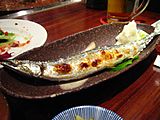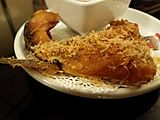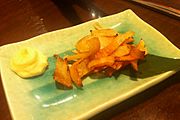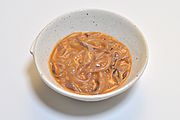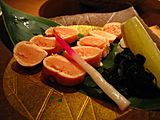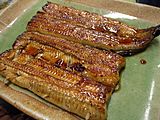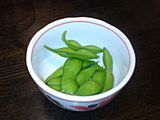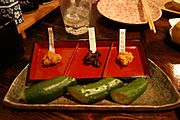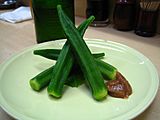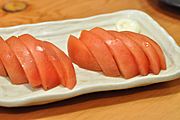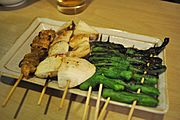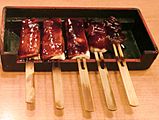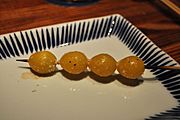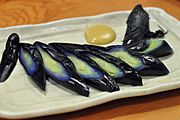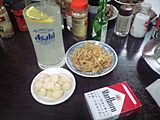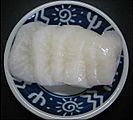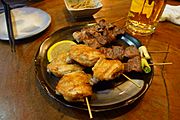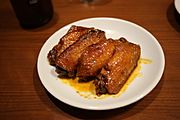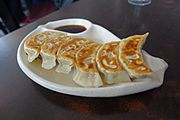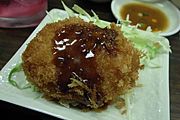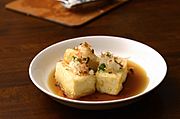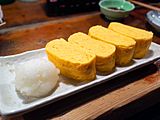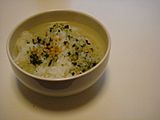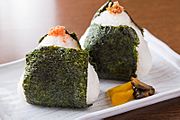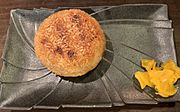Sakana facts for kids
In Japan, people often enjoy small dishes called sakana (肴), shukō (酒肴), or otsumami (お摘み) when they have drinks. These dishes are usually a bit salty and served in small amounts. Think of them like tasty snacks that go well with your drink!
Sakana are often more filling than tapas (Spanish snacks), but they are not a full meal because they don't usually come with rice. Long ago, people in Japan thought of sake (a drink made from rice) as a kind of substitute for white rice. So, some people would not eat rice and drink sake at the same time.
You can find sakana in special Japanese restaurants called izakaya. When you first sit down in an izakaya, they often bring a small starter dish called an otoshi (お通し). This is like a welcome appetizer, and there's usually a small charge for it on your bill. Common otoshi dishes include cabbage salad, Japanese potato salad, tsukemono (pickles), and shiokara (fermented seafood). You can order more sakana as you go, and they come out a few at a time. It's also common to order a different kind of sakana as a shime (last dish). Shime are often softer foods like noodles or sweeter ones like tamagoyaki (a rolled omelet).
People also enjoy sakana at home. There are many cookbooks with easy recipes for making sakana at home. Stores like combini (convenience stores) and supermarkets often sell pre-packaged dried snacks, canned foods, and pickles that are perfect as sakana.
Originally, sakana were made to go with shochu or sake. But since the 1800s, Japanese beer has become very popular in Japan. In 1959, beer became more popular than sake! Because of this, many new foods were created to go specifically with beer. There are even sakana designed to be paired with wine now.
Sakana dishes include both traditional Japanese foods (called washoku) and dishes influenced by Western cooking (called yōshoku). It's common to find things like Naporitan (Japanese pasta), pizza, cheese, gyoza (dumplings), kimchi (spicy Korean cabbage), and namul (Korean vegetable dishes) in modern izakaya. Some of the most popular sakana are actually yōshoku dishes, like potato salad, korokke (croquettes), and other deep-fried foods.
Contents
What's in a Name? The Meaning of Sakana

The word sakana traditionally means food served with sake. It comes from two Japanese words: saka (meaning sake) and na (meaning side dish). Because dried fish and salted fish eggs were popular choices for these dishes, over time, the word sakana also came to mean "fish."
Another common word for a snack in Japanese is otsumami (お摘み). The word tsumami means "something to nibble on with a drink." When you add the polite prefix o to it, it becomes otsumami. This term usually refers to smaller, simpler dishes. Otsumami are often easy to prepare at home or are served as the otoshi (the first dish you get at an izakaya). Since otoshi are placed on the table as soon as customers sit down, they are usually dishes that can be made ahead of time and served cold. This makes them great for home cooks who want to prepare a variety of snacks.
Sometimes, people also use the word ate (あて) or ategau (あてがう), which means "accompaniment," to talk about foods that go well with drinks.
Types of Sakana: Delicious Snacks to Try
When you're drinking at home, sakana can be very simple. Someone living alone might just open a can of mackerel in miso or soy sauce. Or they might grab a pre-packaged sakana like pickles or Japanese potato salad from a supermarket. Some sakana, like kaki no tane (rice crackers with peanuts), are often enjoyed by bachelors or older men.
Here are some common types of sakana you might find:
- Yakitori - Grilled skewers of chicken or chicken parts.
- Kushiage - Deep-fried skewers of meat or vegetables.
- Sashimi - Thin slices of raw fish.
- Tsukemono - Various kinds of pickles.
- Kimchi - Spicy fermented cabbage from Korea.
Sakana Popular with Beer
- Edamame - Salted and boiled soybean pods.
- Nankotsu (chicken cartilage) karaage - Deep-fried chicken cartilage.
- Sausages - Small sausages.
Sakana Popular with Sake
- Shiokara - Fermented, salted seafood, often squid insides.
- Roe (fish eggs):
- Uni - Sea urchin roe.
- Ikura - Red caviar (salmon roe).
- Mentaiko - Spicy pollock roe.
- Tarako - Pollock roe.
- Sujiko - Salted salmon roe.
Small and Easy Snacks
- Atarime / Ika Ichiya-boshi - Dried squid.
- Ei-hire - Dried skate fin.
- Seaweed - Dried or seasoned seaweed.
- Cheese - Small pieces of cheese.
- Peanuts or other nuts (like almonds).
- Potato chips or fried potato sticks.
- Arare - Small crackers made from rice flour.
- Tatami iwashi - Tiny dried sardines pressed into a cracker shape.
Examples of Sakana Dishes
- Fish and seafood
-
Sanma grilled with salt
-
Umitake kasuzuke, clam pickled in sake lees
-
Grilled mentaiko
- Vegetables and pickles
-
Cucumber with hatcho miso
-
Japanese potato salad
-
Roasted ginkgo nuts
-
Bettarazuke, pickled daikon
- Meat and poultry
-
Assorted yakitori
-
Gyoza (dumplings), often with pork
-
Korokke (croquettes)
-
Nikujaga (beef and potato stew)
- Tofu and eggs
-
Hiyayakko (chilled tofu)
-
Tamagoyaki (rolled omelet)
- Commercially packaged otsumami
-
Tatami iwashi (dried sardine crackers)
Sakana in Movies and Shows
Sakana are a normal part of daily life in Japan. Japanese TV shows, magazines, and newspapers often share recipes for making sakana at home.
There are also many food manga (Japanese comics) and anime (Japanese animation) that show sakana. Here are a few examples:
- Shin'ya Shokudō is a long-running food manga about a diner owner who makes sakana for his interesting customers. The diner is only open from midnight to dawn. This manga has also been made into a live-action TV show called Midnight Diner. Unlike a regular izakaya, the owner will make almost any food a customer asks for if he has the ingredients.
- Takunomi. is a 4-panel manga and anime about drinking at home. Each episode shows a different drink. Because of Japanese culture, many different sakana and otsumami are shown with each drink. People in Japan rarely drink alcohol without also having some food.
- Wakakozake is a manga and anime about a main character who loves finding the perfect sakana to go with her drink.
See also
 In Spanish: Sakana para niños
In Spanish: Sakana para niños


